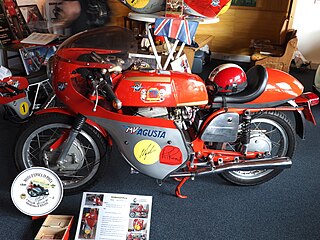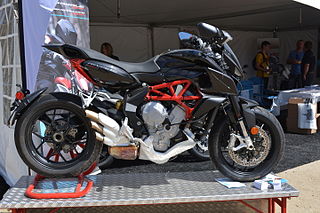
MV Agusta is a high end motorcycle manufacturer founded by Count Domenico Agusta on 19 January 1945 as one of the branches of the Agusta aircraft company near Milan in Cascina Costa, Italy. The abbreviation MV stands for Meccanica (mechanics) Verghera, the hamlet where the first MVs were made. The modern headquarters and main production facilities are located in Varese, Italy on the shore of Lake Varese.

The MV Agusta Brutale series of motorcycles are manufactured by MV Agusta of Italy, starting in 2001. Its style is classified as a naked bike and the series consists of several models powered by either inline-four or inline-three, DOHC-engines in various capacities.

The MV Agusta 750 S also known as the MV Agusta 750 Sport, was a motorcycle manufactured by the MV Agusta company from 1970 to 1975. Production total of this model series was 583 machines.

The MV Agusta 250 Monocilindrica Bialbero was a 250 cc factory racer manufactured by the Italian brand MV Agusta from 1956 to 1959. With this machine 15 GPs, 2 Driver Championships and 2 manufacturers World Championships were won.

The MV Agusta 250 Bicilindrica was a 250 cc factory racing motorcycle manufactured by the Italian brand MV Agusta from 1957 to 1961. With this machine 11 GPs, 2 Driver Championships and 2 manufacturers World Championships were won.

The MV Agusta 175 were a series of motorcycles produced by the Italian manufacturer MV Agusta from 1953 to 1960. The series included touring, GT, sports and supersports models. There were also two racing variants. Because of the shape of the petrol tank, the sports and supersport models became known as the Disco Volante. The series was MV's best seller.

The MV Agusta 125 Bialbero was a 125 cc factory racer from the Italian brand MV Agusta, which was used between 1950 and 1960. The machine won 34 GPs, 6 rider's championships and one manufacturer's championship. The machine also won 4 Italian Championships and 10 National Championships in other countries.

The MV Agusta 125 Pullman was a motorcycle produced by the Italian manufacturer MV Agusta from 1953 to 1956. The model achieved a good sales success, and had the highest production of any machine from MV Agusta. Many brought the bike as the only means of family transport or as a work vehicle. Despite the questionable aesthetics, the Pullman offered a comfortable ride, derived by the driving position, soft suspension and large section tires. This was particularly appreciated by users, so much so that they were imitated by some competitors. 27,000 machines of this model series were produced. The model was also produced under licence in Spain by Avello, where it was marketed as the MV Avello 125 Pullman Turismo.

The MV Agusta Rivale is a motorcycle that was produced by the Italian manufacturer MV Agusta from 2013 to 2017.

The MV Agusta Dragster is a series of motorcycles produced by the Italian manufacturer MV Agusta. The bike is considered a streetfighter, or muscle bike, and is powered by an 800cc three-cylinder engine. Originally introduced in 2014 as the Brutale Dragster 800, part of the Brutale model lineup, the Dragster range was expanded and offered as its own series.

The MV Agusta 350 Ipotesi (Hypothesis) was a motorcycle produced by the Italian manufacturer MV Agusta from 1975 to 1977. The machine was conceived by Italian designer Giorgetto Giugiaro and based on the previous 350 B Sport Elettronica model. 1,991 "Sports" and 350 “Turismo” machines were produced.

The MV Agusta 125 Regolarità was a dual-sport motorcycle built from 1965 to 1970 by the Italian manufacturer MV Agusta at their Cascina Costa plant. Production was 63 machines, built in 2 batches; 46 in 1965 and 17 in 1969.

The MV Agusta 125 Sport SE was a sport motorcycle built from 1975 to 1977 by the Italian manufacturer MV Agusta. It was one of the last models to be produced by Meccanica Verghera at their Cascina Costa plant.

The MV Agusta 150 Sport RS was a motorcycle produced by the Italian motorcycle MV Agusta in their Cascina Costa plant from 1959 to 1969.

The MV Agusta Raid was a series of 250 and 300 cc motorcycles manufactured by the MV Agusta company in Cascina Costa, Italy from 1957 to 1961. At the time of introduction, the 250 cc class was considered a large capacity motorcycle.
The MV Agusta 250B (Bicilindrica) was a motorcycle produced by the Italian manufacturer MV Agusta from 1968 to 1971. The motorcycle was first introduced at the 1965 Milan EICMA motorcycle show and was based on the stillborn MV 166 Arno GT. The model was discontinued in 1971 following the introduction of an overbored version, the 350B.

The Ducati 350 Mark 3 is a 340 cc (21 cu in) single cylinder bevel drive SOHC motorcycle produced by the Italian manufacturer Ducati from 1968 to 1974. It was one of the first 'wide case' Ducati singles produced. A higher performance version, the Ducati 350 Mark 3D, which used desmodromic valves was also available.
The Ducati 450 Mark 3 is a 436 cc (26.6 cu in) single cylinder bevel drive SOHC motorcycle produced by the Italian manufacturer Ducati from 1969 to 1974. The 450 was largest displacement version of the OHC single series produced by Ducati and used the 'wide case' engine. A higher performance version, the Ducati 450 Mark 3D, which used desmodromic valves was also available. The 450 was criticised for vibration and lack of performance compared to other models such as the Mach 1.

The Ducati 250 Mark 3 is a 249 cc (15.2 cu in) single cylinder bevel drive SOHC motorcycle produced by the Italian manufacturer Ducati from 1967 to 1974. Initially produced using the 'narrow case' engine, the newly introduced 'wide case' engine was used from 1968. A higher performance version, the Ducati 250 Mark 3D, which used desmodromic valves was also available.

The Ducati Road 250 is a 247 cc (15.1 cu in) single cylinder bevel drive SOHC motorcycle produced by the Spanish manufacturer MotoTrans, who were licensed by Ducati to produce motorcycles under the Ducati brand name and was produced from 1972 to 1977. The model was intended to be a Spanish domestic market version of the 250 Scrambler, although it was also exported to the US in 1972/3.






















